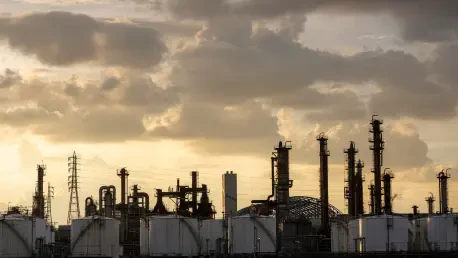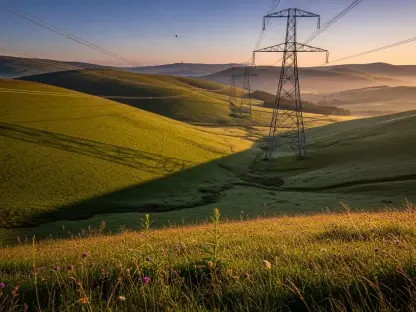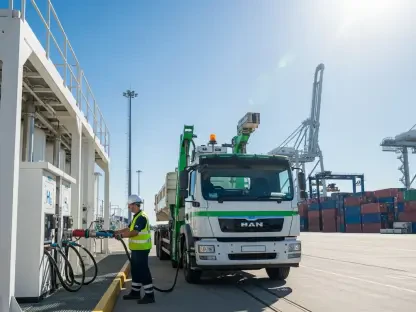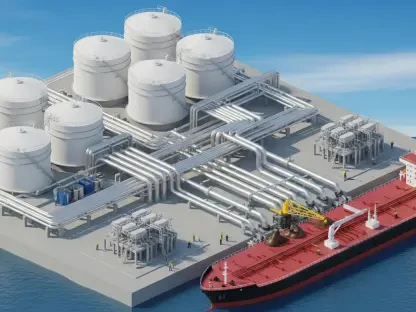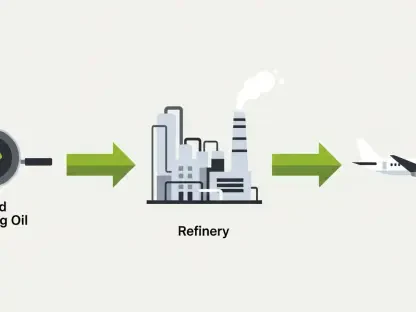What happens when a nation’s energy lifeline turns into a battlefield target, transforming the economic foundation into a vulnerable front line? Across Russia’s sprawling landscape, plumes of smoke rise from oil refineries and pipelines, struck by Ukrainian drones in a relentless campaign. This isn’t just warfare on the ground—it’s a calculated strike at the economic heart of one of the world’s top energy producers. The explosions and shutdowns signal a conflict that transcends soldiers and tanks, reaching into the very fuel that powers a country and its global influence.
A Bold New Battleground: Energy as a Weapon
The shift in modern warfare is starkly visible in Russia’s burning energy hubs. Ukrainian drone strikes have targeted critical infrastructure, from vast refineries to vital pipelines, exposing a new front where economic stability is the casualty. These attacks, ongoing for months, aim to disrupt the flow of oil and gas that sustains Russia’s domestic needs and international power. The strategy is clear: cripple the resources that fund and fuel an adversary’s war machine.
This isn’t a random act of destruction. Energy infrastructure has become a deliberate focus, with strikes designed to inflict maximum logistical chaos. Facilities once considered safe behind battle lines are now vulnerable, as drones bypass traditional defenses to hit targets deep within Russian territory. The fires and operational halts are not just physical damage—they’re a message that no sector is untouchable in this evolving conflict.
Why Energy Strikes Hit So Hard
Russia’s economy leans heavily on its energy sector, a pillar that accounts for a significant chunk of national revenue and global supply. Disrupting this system doesn’t just hurt domestic operations; it sends shockwaves through international markets and allied nations. For instance, the Druzhba pipeline, a key conduit for oil to Europe, has been a focal point, with attacks threatening supplies to countries like Hungary and Slovakia, amplifying the geopolitical stakes.
These strikes reveal a deeper vulnerability. Energy isn’t merely a commodity—it’s a lifeline for military logistics and civilian life. By targeting refineries and pumping stations, Ukrainian forces aim to erode Russia’s financial backbone, potentially curbing its ability to sustain prolonged conflict. The ripple effects touch global energy prices, hinting at broader consequences for consumers and economies far beyond the conflict zone.
Moreover, the precision of these drone operations underscores a strategic intent to exploit weaknesses in Russia’s sprawling energy network. Unlike traditional military targets, these facilities are often less fortified, making them susceptible to aerial assaults that can halt production for weeks. This tactic shifts the battlefield into an economic arena, where the cost of recovery could outstrip the price of conventional warfare.
Pinpointing the Destruction: Where and How Hard
The scale of disruption is staggering, with Ukrainian drones striking energy facilities across Russia’s diverse regions. The Unecha pumping station in Bryansk, tied to the critical Druzhba pipeline, endured multiple hits, including a significant attack on August 21 that led Hungary and Slovakia to brace for a five-day oil supply suspension. Earlier strikes, like one on August 13, sparked fires and damage, though crude flows initially persisted, showing the resilience and fragility of such systems.
Refineries have also taken heavy blows, with major plants in Samara (Syzran), Volgograd, Krasnodar (Slavyansk, Afipsky, Ilsky), Saratov, Sochi, Novokuibyshevsk, and Ryazan reporting fires and explosions. The Syzran and Volgograd refineries halted production entirely at times, while Ryazan, struck repeatedly, saw its capacity slashed by half after an August 2 attack. These incidents, spanning from early this year into late summer, illustrate a persistent campaign to dismantle Russia’s energy production.
Operational chaos compounds the physical toll. Shutdowns lasting days or weeks have become routine, as seen with Lukoil’s Volgograd refinery, which closed for over a week in February and faced similar disruptions in August. This pattern of sustained attacks on both production and distribution hubs reveals a calculated effort to paralyze key nodes in Russia’s energy grid, stretching from southern territories to central industrial zones.
Hearing the Impact: Voices from the Crisis
Military experts and local reports paint a picture of deliberate economic warfare. A Ukrainian military source emphasized the intent, stating, “Striking energy infrastructure cuts the arteries of Russia’s war effort—it’s as vital as any territorial gain.” This perspective highlights the strategic weight behind each drone mission, aiming to sap resources that fuel military operations and national stability.
On the Russian side, officials often downplay the severity, with authorities in Krasnodar asserting that fires at struck refineries were quickly contained. Yet, the recurring nature of attacks on high-value targets like the Ryazan refinery suggests a deeper impact on output and morale. Workers at these sites, faced with sudden infernos and urgent repairs, embody the human struggle amid the statistics, as engineers race against time to restore critical functions.
The fallout extends beyond immediate damage, as industry analysts warn of long-term setbacks. The repeated targeting of specific facilities indicates a learning curve in Ukrainian tactics, adapting to maximize disruption. Meanwhile, stories of communities near these sites, living under the shadow of potential explosions, add a poignant layer to the narrative, showing how this conflict permeates everyday life.
Countering the Chaos: Steps to Mitigate the Fallout
Addressing the repercussions of these strikes demands actionable responses from various stakeholders. Nations reliant on Russian energy, such as Hungary and Slovakia, must prioritize diversifying supply sources and building strategic reserves to weather sudden disruptions. This proactive approach can buffer against the uncertainty of pipeline halts and refinery shutdowns.
Energy firms, both in Russia and globally, face a pressing need to bolster defenses against drone warfare. Investing in advanced detection and interception technologies could safeguard critical infrastructure from aerial threats, a lesson drawn from the current crisis. Such measures, while costly, are essential in an era where energy security is increasingly intertwined with military strategy.
For markets and consumers, staying informed about the volatility triggered by these attacks is crucial. Monitoring shifts in oil prices and trade routes can help anticipate economic impacts, allowing for better planning and adaptation. These steps collectively offer a framework to navigate a landscape where energy infrastructure is no longer a safe haven, pushing for resilience in the face of unconventional threats.
Reflecting on a War of Resources
Looking back, the systematic Ukrainian drone strikes on Russia’s energy infrastructure marked a defining chapter in modern conflict, where economic targets bore the brunt of military strategy. The fires at refineries like Syzran and Volgograd, alongside the threatened Druzhba pipeline flows, underscored a vulnerability that reshaped perceptions of warfare. Each attack, from Bryansk to Krasnodar, etched a story of disruption into the fabric of global energy dynamics.
Moving forward, the focus shifted to strengthening international cooperation on energy security, urging nations to rethink reliance on single supply chains. Collaborative efforts to develop alternative energy sources and fortify protective measures emerged as vital next steps. The lessons from these strikes called for a unified push toward innovation, ensuring that the lifeblood of economies could withstand the shocks of war in an interconnected world.
